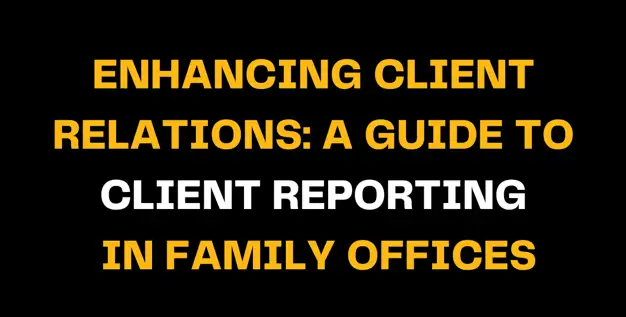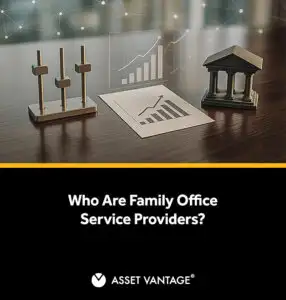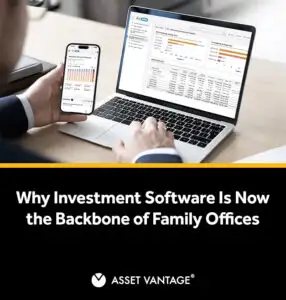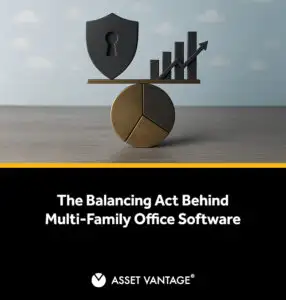Read Time5 Mins
Client reporting is at the heart of every family office’s client relations strategy. It’s more than just a statement of financial holdings; it’s a powerful tool for building trust, demonstrating value, and ensuring clients have a clear understanding of them through wealth management. In this blog, we’ll explore how family offices can enhance client relations through effective client reporting, leveraging family asset management software and family office solutions.
Introduction
In the dynamic landscape of family wealth management, maintaining robust client relations is vital. Client reporting is the medium through which family offices can communicate complex financial information effectively, fostering stronger connections and trust with their clients.
Key Points
- Transparency is Key: In the complex world of wealth management, transparency is non-negotiable. Clients need to trust that their family office is acting in their best interests. Transparent, jargon-free reports provide a clear view of financial holdings and performance. By employing family office software, you can create visually engaging and straightforward reports. This transparency helps build trust and assures clients that their interests are at the forefront.
- Customization is King: Every client is unique with different financial goals and preferences. Effective client reporting involves tailoring reports to meet these specific needs. Using family office solutions, you can generate customizable reports that allow clients to focus on the information that’s most relevant to them. This tailored approach demonstrates a commitment to understanding their individual financial objectives.
- Frequent Updates: Consistent and regular reporting is a vital aspect of maintaining strong client relations. By providing frequent updates through family asset management software, you keep clients well-informed about their holdings and financial progress. This ongoing communication ensures that your clients remain engaged and connected to the wealth management process.
- Interactive Reports: Client reports need not be static documents. Utilizing family office software, you can create interactive reports. These reports can include charts, graphs, and other visual aids that make complex data more digestible. Interactive reports enable clients to explore their financial data, fostering a more engaging and educational experience.
- Performance Analysis: A key component of client reporting is demonstrating how investments are performing. Reports should not only show current holdings but also provide historical performance data. Through these insights, clients can better understand how their investments are faring and whether they align with their financial goals.
- Risk Management Insights: Assessing and managing risks is central to any investment strategy. Through detailed reporting, clients can gain insights into the risks associated with their investments. They should understand how these risks are being managed and mitigated by your family office, enhancing their confidence in your services.
- Asset Allocation Clarity: Asset allocation is a critical aspect of wealth management. In your reports, it’s important to clearly show how a client’s wealth is diversified across different assets. This transparency allows clients to assess the balance of their portfolio and evaluate the potential impact of allocation changes on their overall financial strategy.
- Real-time Updates: In today’s fast-paced financial markets, clients value access to real-time data. Utilizing software with real-time capabilities, you can provide clients with immediate updates on their holdings and financial status. This up-to-the-minute information assures clients that you are actively monitoring and managing their investments.
- Tax Efficiency Reports: Reports should include tax-related information and strategies. Clients need to understand how tax efficiency is being integrated into their financial management. These reports showcase the comprehensive nature of your services and provide clients with insights into the tax implications of their investments.
- Educational Value: Client reports can also serve as valuable educational tools. Use them to explain investment decisions, strategies, and how these align with a client’s financial objectives. By adding this educational dimension, you empower clients to be more engaged and informed participants in their wealth management, fostering stronger and longer-lasting client relationships.
Conclusion
In conclusion, enhancing client relations through effective client reporting is a cornerstone of successful family offices. The use of advanced family office solutions and family asset management software has revolutionized the way we approach client reporting.
Today, it’s not merely about sharing financial statements; it’s about creating a dynamic and educational experience. By adopting transparency, customization, and the use of interactive and real-time reports, family offices can build trust and confidence in their clients. This trust is fundamental to client relations and often leads to long-lasting partnerships.
Moreover, in a world marked by financial complexities and risks, providing insightful reports that break down performance, risk management, and asset allocation is pivotal. These reports offer clients not just data, but knowledge, ensuring they understand their financial situation and the strategies being employed to meet their goals.
Furthermore, client reports that emphasize tax efficiency and provide educational value make clients more informed and active participants in their wealth management. This educational approach empowers clients to make well-informed decisions and be more engaged in their financial future.
By embracing these practices, family offices can build robust client relations that are characterized by trust, transparency, and a commitment to meeting individual client needs. In this way, effective client reporting becomes a dynamic tool for nurturing and sustaining strong client relationships, a true reflection of excellence in wealth management services.







